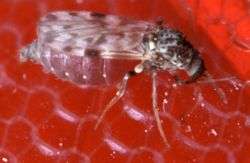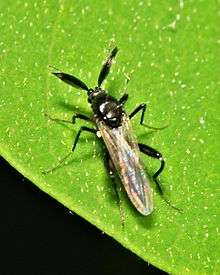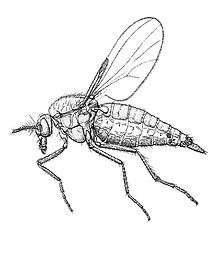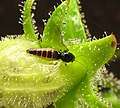Ceratopogonidae
Ceratopogonidae is a family of flies commonly known as no-see-ums, or biting midges, generally 1–3 mm in length. The family includes more than 5,000 species,[1] distributed worldwide, apart from the Antarctic and the Arctic.
| Ceratopogonidae | |
|---|---|
 | |
| A female biting midge, Culicoides sonorensis | |
| Scientific classification | |
| Kingdom: | Animalia |
| Phylum: | Arthropoda |
| Class: | Insecta |
| Order: | Diptera |
| Suborder: | Nematocera |
| Infraorder: | Culicomorpha |
| Superfamily: | Chironomoidea |
| Family: | Ceratopogonidae Newman |
Ceratopogonidae are holometabolous, meaning their development includes four life stages: egg, larva, pupa, and imago or adult. Most common species in warmer climates will take about two to six weeks to complete a life cycle. Both adult males and females feed on nectar. Most females also feed on the blood of vertebrates, including humans, to get protein for egg-laying. Their bites are painful, and can cause intensely itchy lesions.[2] Their mouthparts are well-developed for cutting the skin of its host. Some species prey on other insects.
Larvae need moisture to develop, but also air and food. They are not strictly aquatic or terrestrial.[2]
Some species within the biting midges are thought to be predatory on other small insects. Particularly mosquito larvae have been investigated as common prey for biting midges in the genus Bezzia. For example, experiments have been conducted on the species Bezzia nobilis that suggest their reliance on mosquito larvae as one source of prey.[3][4]
Like other blood sucking flies, the Culicoides species can be vectors of disease-causing pathogens. Among diseases transmitted are the parasitic nematodes Mansonella, bluetongue disease, African horse sickness, epizootic hemorrhagic disease, arboviruses,[5] and nonviral animal pathogens.[6]
Historically, numbers were managed with the insecticide DDT[2] as with Leptoconops torrens populations in California. They can be trapped by luring them with carbon dioxide. Most midges are small enough to pass through ordinary insect window screening. They can be repelled with DEET,[2] oil of eucalyptus, or Icaridin. Their larvae have also been shown to be susceptible to treatment with commercially available preparations of Bacillus thuringiensis israelensis.[7]
Subfamilies
The Leptoconopinae is a subfamily of biting midges.[8] The larvae are recognized by their unique sclerites of the head, and by their mouthparts.
The Forcipomyiinae are a subfamily of biting midges. In this subfamily, both anterior and posterior prolegs are present on the larvae. Larvae are both terrestrial and aquatic, and feed primarily on algae and fungi. Some species are important pollinators of tropical crops such as the cocoa bean.
Larvae of species in the Dasyheleinae subfamily are characterized by an anal segment with retractile posterior prolegs. Larvae are aquatic and adults do not feed on vertebrate blood, nor do they prey on other insects. They take nectar only, an unusual feeding behavior within the Ceratopogonidae.
The Ceratopogoninae subfamily has elongated larvae without prolegs or hooks. Most larvae of this subfamily are predatory. Adults generally take vertebrate blood or attack other insects.
Gallery
 Ceratopogonid male
Ceratopogonid male Leptoconops
Leptoconops- Ceratopogonid feeds on a mantis
 Palpomyiini caught by sticky hairs of penstemon
Palpomyiini caught by sticky hairs of penstemon
References
- Boorman, John (1993). "Biting midges (Ceratopogonidae)". Medical Insects and Arachnids. Springer. pp. 288–309. doi:10.1007/978-94-011-1554-4_7. ISBN 978-94-010-4679-4.
- "common name: biting midges, no-see-ums, scientific name: Culicoides spp. (Insecta: Diptera: Ceratopogonidae)". Featured Creatures. University of Florida. Retrieved 20 September 2018.
- Hribar, L. J. & G. R. Mullen.Predation by Bezzia larvae (Diptera: Ceratopogonidae) on mosquito larvae (Diptera: Culicidae). Entomol. News 102: 183-186.
- Mogi, M. Insects and other invertebrate predators. Journal of the American Mosquito Control Association, 23(sp2):93-109 (2007). https://doi.org/10.2987/8756-971X(2007)23%5B93:IAOIP%5D2.0.CO;2.
- Carpenter, Simon; Groschup, Martin H.; Garros, Claire; Felippe-Bauer, Maria Luiza; Purse, Bethan V. (2013). "Culicoides biting midges, arboviruses and public health in Europe". Antiviral Research. 100 (1): 102–113. doi:10.1016/j.antiviral.2013.07.020. ISSN 0166-3542. PMID 23933421.
- Linley, J. R. (1985). "Biting midges (Diptera: Ceratopogonidae) as vectors of nonviral animal pathogens". Journal of Medical Entomology. 22 (6): 589–599. doi:10.1093/jmedent/22.6.589. ISSN 0022-2585. PMID 3908679.
- "World Health Organization" (PDF). WHO.int. World Health Organization. Retrieved 1 April 2020.
- Borkent, Art; Craig, Douglas A (23 August 2004). "Austroconops Wirth and Lee, a Lower Cretaceous genus of biting midges yet living in Western Australia: a new species, first description of the immatures and discussion of their biology and phylogeny (Diptera: Ceratopogonidae)". American Museum Novitates. 3449: 1–2. doi:10.1206/0003-0082(2004)449<0001:AWALAL>2.0.CO;2. hdl:2246/2814.